Reurbanizing Jefferson & Lafayette Pt 2: Foodland
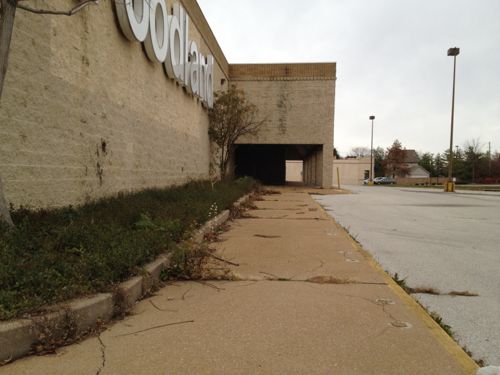
The long-vacant Foodland grocery store (1601-45 S. Jefferson) was in the news recently:
Developer Green Street Properties has filed plans with the City of St. Louis to rehab the empty 47,000 supermarket, and hopes to fill it with a smaller grocery store and other retailers. It has a contract to buy the building and hopes to start a $6.6 million first phase in the spring, with a second phase potentially to come later.
The store – just across Jefferson Ave. from Lafayette Square – has sat empty since 2004, when Foodland closed after failing to get neighborhood support for a liquor license. It had previously been a National store. Much of the surrounding neighborhood is now considered a “food desert” by the U.S. Department of Agriculture, for lack of grocery options. (STLtoday)
On Saturday I posted about the SE corner of Jefferson & Lafayette, how a 2007 residential & retail building is a starting point for reurbanizing this intersection. This grocery store was occupied for only 20 years (1984-2004) before being vacated 7 years ago. That’s a rather sad statement but not really surprising given how out of context it is.
This post will critique of 70s & 80s planning theory that created the existing problems. Part 3 tomorrow will look at possible solutions.
Street Grid:
The short-block walkable street grid was always decimated by development. Street closures are still common practice in St. Louis.
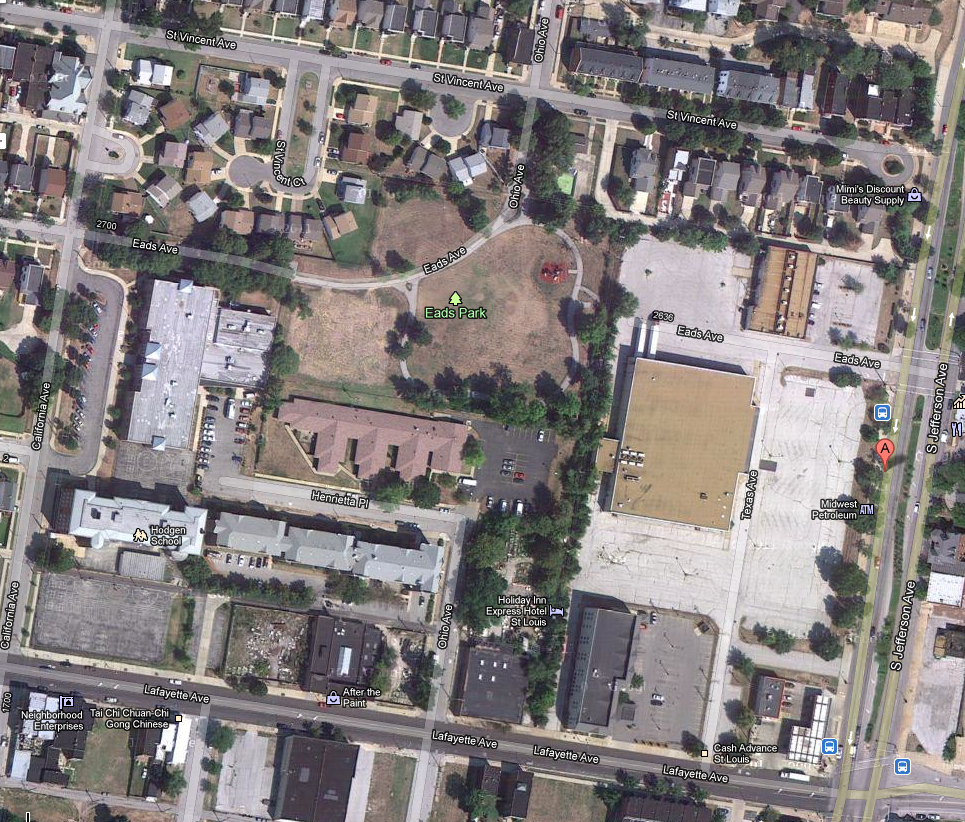
Eads Ave east of California Ave was removed, Ohio Ave was removed from St. Vincent Ave to Henrietta Pl and Texas Ave became lost in a sea of parking. Cul-de-sacs were created for new housing built in 1979, the same year the television series Knots Landing premiered (set on a California cul-de-sac). Yes, Eads Park was created from the replatting of the land but that doesn’t justify the disruption in the grid — the connectedness of the area.
Isolation:
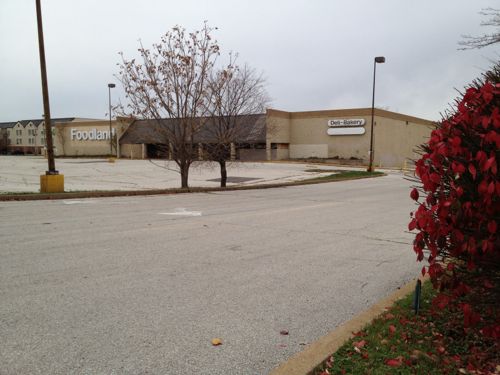
The nearby houses were only 5 years old when this grocery store opened as a National in 1984. Still, it wasn’t designed to be walked to from houses that could see the store from their windows. The single access point from Jefferson Ave is an auto drive where Eads Ave used to be located. St. Louis’ population in 1980 was 452,801 and in 1990 it was 396,685 — both significantly greater than our 2010 count of 319,294.
Today those remaining still walk to the store, but now their choices are limited to gas station convenience stores.
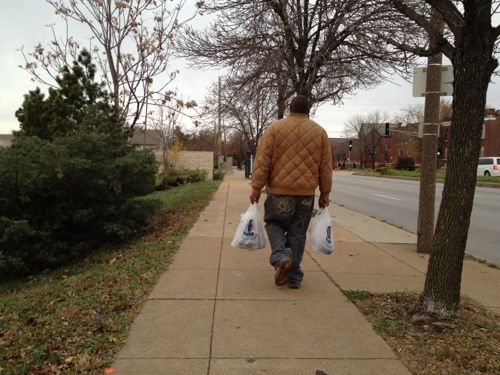

These last two guys cut by the side of the store to go through an opening in the fence to reach the park and residences beyond.
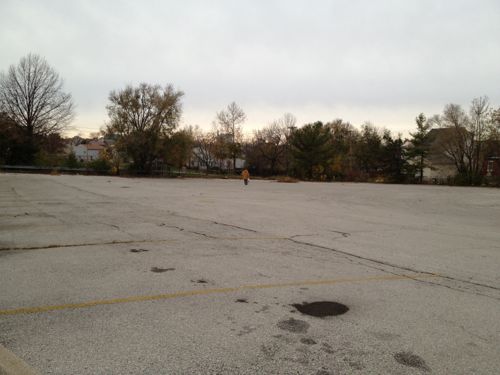
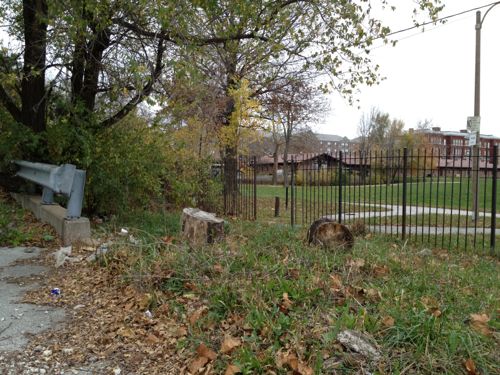
Lack of Connection within the development
In addition to deliberately not connecting to the city beyond the boundaries of the property even new construction isn’t connected to each other, everyone is expected to drive from place to place.
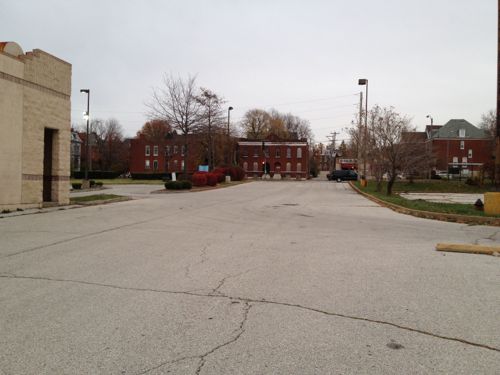
In 1991 a small retail building was built on a separate parcel to the north of the grocery (far left above). The auto access drive, once a public street, is part of the grocery property. The parcel with the retail building was likely  granted an easement to use the drive for auto access. Developed after the passage of the Americans with Disabilities Act (ADA), it has no concern for pedestrians entering from Jefferson or even the adjacent grocery store. Plenty of auto parking though.
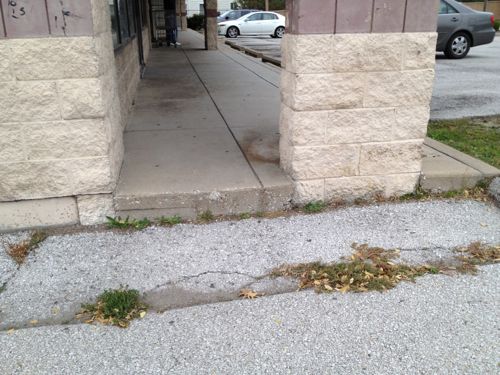
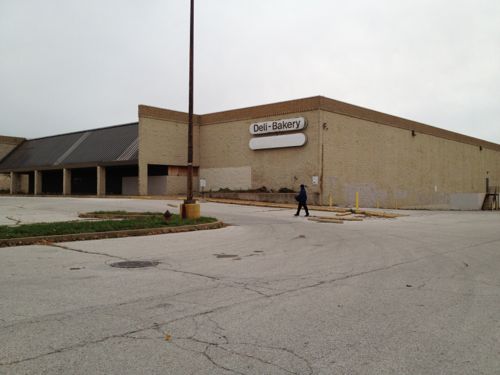
Reaching the site
The problems aren’t limited to the site.
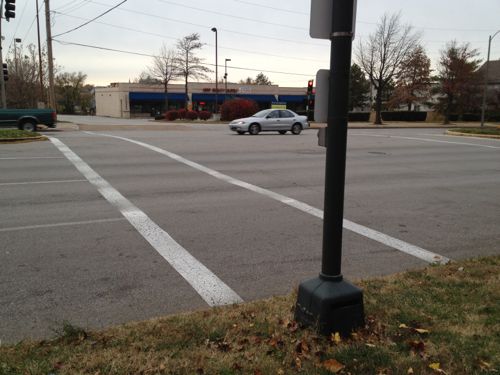
Perhaps the attitude was “why bother?” since no pedestrian route exits to the front of the buildings. It’s no surprise to me this has failed as a retail draw, urban customers must be able to reach the stores by foot as well as car.
Corner Gas Station:
The NW corner of Jefferson & Lafayette has had a gas station since  1950. The building has changed but the issues have been the same for more than six decades.
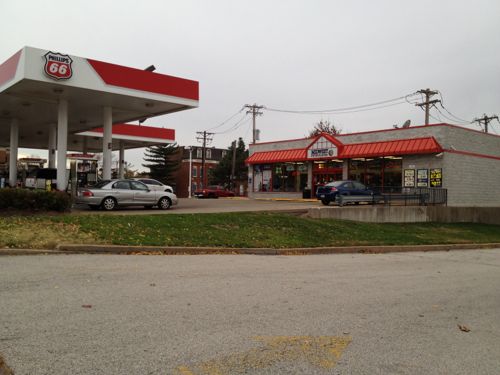
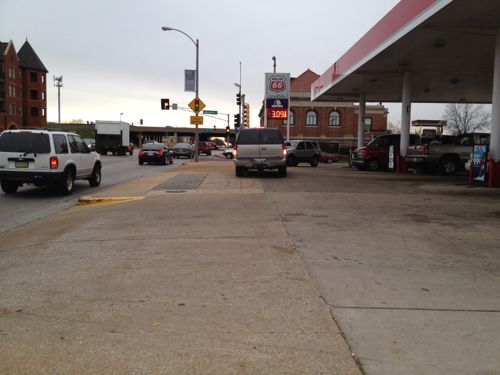
The pedestrian space is lost, overtaken by autos. A public library branch is across Lafayette Ave., Â in the background. Let’s get around to Lafayette Ave, the south edge of the area.
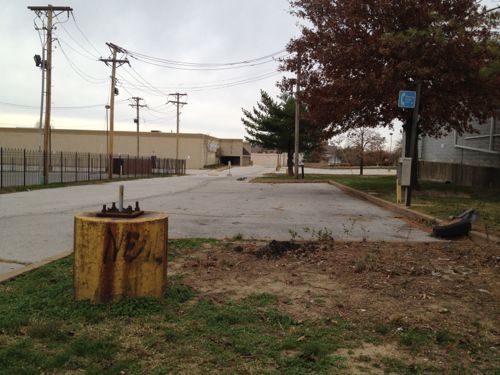
In 1998 a Holiday Inn Express was built on a separate parcel south of the still-open grocery store.
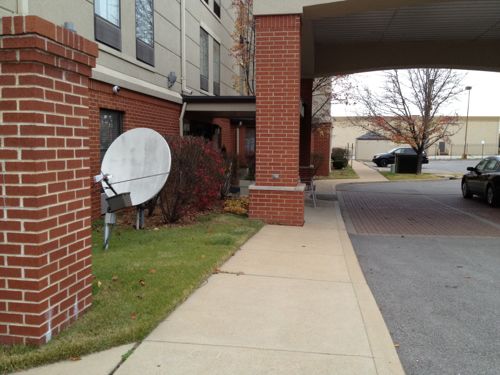
I was barely able to get past the brick columns and I had to move a bench on the sidewalk under the canopy to be able to head toward the grocery store.
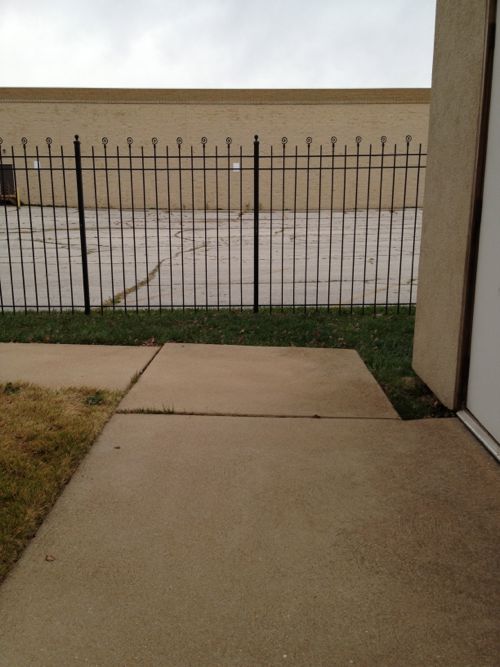
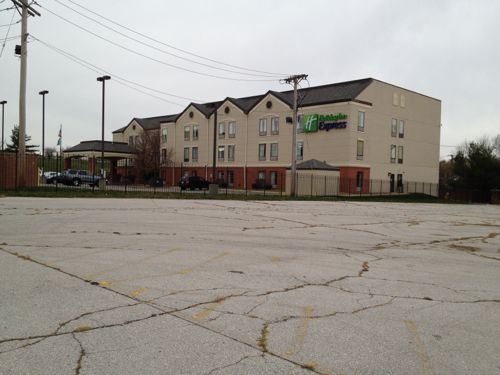
I reviewed Historic Aerials from 1958, 1971, 1998 and later for this post. Â Search for 1601 S. Jefferson 63104 to view for yourself. Tomorrow I will offer my thoughts on how Green Street Properties together with adjacent property owners and the city can connect the retail to the surroundings.
– Steve Patterson
Great post, Steve. Â This intersection is a total disaster. Â The fact that it is located directly adjacent to Lafayette Square makes it all the more absurd. Â Given the modern mixed-use development models that have been embraced in many other US cities, I can’t understand why the new proposal for this site wouldn’t include a complete redevelopment of this mess. Â Is there anything we can do to encourage the developers to rebuild rather than renovate?
Great post, Steve. This intersection is a total disaster. The fact that it is located directly adjacent to Lafayette Square makes it all the more absurd. Given the modern mixed-use development models that have been embraced in many other US cities, I can’t understand why the new proposal for this site wouldn’t include a complete redevelopment of this mess. Is there anything we can do to encourage the developers to rebuild rather than renovate?
Yes, inadequate pedestrian access caused economic failure — not a major loss of population caused by failing schools and a diminished middle class. Laughable.
Yes, inadequate pedestrian access caused economic failure — not a major loss of population caused by failing schools and a diminished middle class. Laughable.
The 1980 population was over 452,000 but new development didn’t retain the middle class as planners thought it would. In the same time frame urban shopping districts well connected to neighborhoods have seen a rebirth. Don’t discount walkability!
And don’t discount busing for desgregation, either. The loss of neighborhood schools has probably done more to both lower student performance and to accelerate the movement of the middle class, especially those with school-age kids, out of the city than anything else.
This unwakable development is across Jefferson Ave from a stable middle & upper middle class neighborhood, Lafayette Square. The market for this retail has existed all along, it just wasn’t designed to attract that market.
The 1980 population was over 452,000 but new development didn’t retain the middle class as planners thought it would. In the same time frame urban shopping districts well connected to neighborhoods have seen a rebirth. Don’t discount walkability!
And don’t discount busing for desgregation, either. The loss of neighborhood schools has probably done more to both lower student pwerformance and to accelerate the movement of the middle class, especially those with school-age kids, out of the city than anything else.
This unwakable development is across Jefferson Ave from a stable middle & upper middle class neighborhood, Lafayette Square. The market for this retail has existed all along, it just wasn’t designed to attract that market.
The schools are still inadequate and yet the neighborhood is coming back. Its not just the schools that caused the movement of the middle class. Btw I love that Lafayette Square’s success is starting to influence the fate of these infrastructure mishaps.
The schools are still inadequate and yet the neighborhood is coming back. Its not just the schools that caused the movement of the middle class. Btw I love that Lafayette Square’s success is starting to influence the fate of these infrastructure mishaps.
Interesting. The original article stated that Foodland closed because they couldn’t get a liquor license, yet you want to argue that poor urban design forced their closure. The “corner gas station” is, as you noted, equally pedestrian unfriendly, yet they were able to secure a beer and wine license, and they continue to stay in business and function as “the neighborhood’s grocery store”. While the sizes of the two businesses are distinctly different, neither one is/was making much off of the grocery component of their businesses – profit margins on groceries are notoriously slim. Profit margins on tobacco and alcohol are significantly higher, so it’s no surprise that retailers want to stock and sell these items to stay profitable.
Having been involved in community-based politics for years, I understand why neighbors would have opposed another liquor license, especially when they’re viewed as catering to the “wrong element” and/or there are other problem liquor licenses nearby (likely the case here). Unfortunately, that opposition kicked in the Law of Unintended Consequences big time – they kept out liquor sales, but they also pushed a retailer from profitable to unprofitable, and they lost the grocery, as well. And while you want to physically connect these developments to the surrounding neighborhoods, many local people simply don’t want any connections, and actually fear the increased traffic development will bring. The result is the barriers – fences, truncated streets, etc. – that are negotiated into development plans – they rarely originate on the developer’s side.
To change this paradigm is going to take both education and a serious change in mindsets. The Holiday Inn Express doesn’t have a fence to keep their guests from leaving their property, they have a fence because they want to keep their guests’ vehicles safe from the surrounding neighborhood. The grocery store has a big parking lot in front because the vast majority of their customers drive (and don’t walk), and not because they have any irrational love for asphalt. Yes, in theory, we could (and probably should) walk to the grocery every two or three days and make small purchases of locally-produced, fresh products that we’re capable of carrying home without driving. In reality, most of us only go grocery shopping two or three times a month, and buy way more than we can carry home on foot.
Finally, it’ll be interesting to see which “smaller grocery store” Green Street Properties has under contract. While my money would be on a Save-a-Lot or an Aldi’s, it would be great to see a Trader Joe’s or a local health foods market moving in, or even a Whole Foods. The least likely answer would be a Culinaria, since there’s way less demand for that format here.
Interesting. The original article stated that Foodland closed because they couldn’t get a liquor license, yet you want to argue that poor urban design forced their closure. The “corner gas station” is, as you noted, equally pedestrian unfriendly, yet they were able to secure a beer and wine license, and they continue to stay in business and function as “the neighborhood’s grocery store”. While the sizes of the two businesses are distinctly different, neither one is/was making much off of the grocery component of their businesses – profit margins on groceries are notoriously slim. Profit margins on tobacco and alcohol are significantly higher, so it’s no surprise that retailers want to stock and sell these items to stay profitable.
Having been involved in community-based politics for years, I understand why neighbors would have opposed another liquor license, especially when they’re viewed as catering to the “wrong element” and/or there are other problem liquor licenses nearby (likely the case here). Unfortunately, that opposition kicked in the Law of Unintended Consequences big time – they kept out liquor sales, but they also pushed a retailer from profitable to unprofitable, and they lost the grocery, as well. And while you want to physically connect these developments to the surrounding neighborhoods, many local people simply don’t want any connections, and actually fear the increased traffic development will bring. The result is the barriers – fences, truncated streets, etc. – that are negotiated into development plans – they rarely originate on the developer’s side.
To change this paradigm is going to take both education and a serious change in mindsets. The Holiday Inn Express doesn’t have a fence to keep their guests from leaving their property, they have a fence because they want to keep their guests’ vehicles safe from the surrounding neighborhood. The grocery store has a big parking lot in front because the vast majority of their customers drive (and don’t walk), and not because they have any irrational love for asphalt. Yes, in theory, we could (and probably should) walk to the grocery every two or three days and make small purchases of locally-produced, fresh products that we’re capable of carrying home without driving. In reality, most of us only go grocery shopping two or three times a month, and buy way more than we can carry home on foot.
Finally, it’ll be interesting to see which “smaller grocery store” Green Street Properties has under contract. While my money would be on a Save-a-Lot or an Aldi’s, it would be great to see a Trader Joe’s or a local health foods market moving in, or even a Whole Foods. The least likely answer would be a Culinaria, since there’s way less demand for that format here.
Can you back up your claim of less demand for a Culinaria format? Most likely the National had a liquor license but when they were bought out by Schnucks and this location was opened by Foodland they struggled for years until their few locations all closed.
Culinaria caters to an urban demographic. It’s essentially an upscale deli/specialty grocery, much like Straub’s, more than a grocery aimed at the demographics of this area (like Aldi’s or Save-a Lot). Yes, Lafayette Square is upscale, but it makes up only a small part of the area surrounding Jefferson & I-44. Much of the rest of the area skews more toward food stamps than Grey Poupon (did you go inside the “corner gas station”?). But, like I said, it’ll be interesting to see which “smaller grocery store” Green Street Properties actually has under contract, since neither you nor I know.
Yet another comment based on your distorted perceptions. Culinaria is far from upscale because, as a regular shopper, I ave to go elsewhere to get upscale items. The merchandiser is a major pack rack. You are very wrong about where Culinaria fits into the local grocery market.
“Distorted perceptions” is an oxymoron. You have your perceptions, as a regular shopper, and I have mine, as an occasional shopper. We both look at the same thing and reach different conclusions. Does that make either one more distorted?! Perceptions are what we each, individually, see and experience. They might not agree, but they are what we see.
You routinely present your perceptions as fact, rather than just your own anecdotal observations.
And you don’t?
I generally try to use qualifiers in my statements.
“Culinaria caters to an urban demographic.”
you mean people who live and/or work and/or visit downtown? doesn’t the Schnucks at Grand and Gravois also cater to an urban demographic?
“It’s essentially an upscale deli/specialty grocery…”
nope. it’s a Schnucks with a more compact footprint and, yes, more prepared foods to service the workday lunch crowds. the stock is somewhere between a corner market and a SUPER ULTRA MEGA market, which is what you would expect considering its size. the prices are even the same as those at their other stores. can you maybe give some examples of the “upscale” or “specialty” items they sell that aren’t also sold at other Schnucks stores?
“Does that make either one more distorted?! … We both look at the same thing and reach different conclusions.”
Yes, the perceptions that lead to the conclusion that is farther from reality (in this case yours) are more distorted.
The Schnuck’s at Grand and Gravois caters to a much more typical suburban, albeit inner ring, demographic than Culinaria does. Even though it’s “in the city”, it serves a part of St. Louis that is much more residential and auto-dependent/centric than the CBD. The same goes for the city’s other Schnuck’s, in the CWE, on the Hill and in Hampton Village. Their delis are different than Culinaria’s, and are aimed more at bulk, take-home purchases, not lunchtime diners, while their grocery sections are much larger, again aimed at the autocentric shopper.
I guess I’m also a victim of Schnuck’s marketing machinery. From the Culinaria website: “Culinaria – A Schnucks Market is named for the distinctive characteristics that make this hybrid urban market the perfect setting for a fine food and culinary experience. Inside, you will find a superb selection of grocery, wine, spirits, prepared foods, Schnucks pharmacy, health and beauty, household essentials and kitchen items. You’ll also find a large selection of premium items, many bearing the Culinaria brand signaling that it was developed just for you.”
Perception is reality. Some of it is driven by marketing, some of it by word of mouth, and much is based on personal experience. And perception will vary from person to person, even from year to year. That doesn’t make one better or more accurate than another, it just makes them different. If you need to classify other people’s as distorted or wrong to justify your own perceptions, so be it. I expect to continue to disagree with other people’s perceptions on a regular basis, not to belittle their views, but to both better understand the details of their perceptions and to refine mine . . .
“The Schnuck’s at Grand and Gravois caters to a much more typical suburban, albeit inner ring, demographic than Culinaria does.”
Grand and Gravois? are we thinking of the same store? that store is only suburban/inner ring inasmuch as the rest of saint louis city is suburban. compared to NYC sure, compared to the suburbs of saint louis, no. And since when has a grocery store been defined by the sale of bulk purchases – oh, yeah, only since fat-assed Americans started driving everywhere. the thing is, many of those who comprise the demographic that would shop at Aldi’s and Save-a-Lot don’t own cars, so they’re not very well served by these mega-stores anyway.
“I guess I’m also a victim of Schnuck’s marketing machinery.”
that’s why you should check your claims against reality instead of marketing.
“That doesn’t make one better or more accurate than another…”
no, you see it DOES make one more accurate than another. Perception CAN BE TESTED AGAINST REALITY. you say Culinaria is an upscale/specialty grocer. this can be TESTED by going to Culinaria and comparing their product and their prices to those of other grocers instead of defending your position based on their marketing.
Actually gas stations make more money selling snacks, sodas,and other food than they do selling gasoline. The food sales are what keep them in business. I have read this several places. I don’t remember seeing a gas station lately that did not include a mini-mart. On the other hand, it is true that grocery stores make only slim margins on the sale of food.
Can you back up your claim of less demand for a Culinaria format? Most likely the National had a liquor license but when they were bought out by Schnucks and this location was opened by Foodland they struggled for years until their few locations all closed.
Actually gas stations make more money selling snacks, sodas,and other food than they do selling gasoline. The food sales are what keep them in business. I have read this several places. I don’t remember seeing a gas station lately that did not include a mini-mart. On the other hand, it is true that grocery stores make only slim margins on the sale of food.
Culinaria caters to an urban demographic. It’s essentially an upscale deli/specialty grocery, much like Straub’s, more than a grocery aimed at the demographics of this area (like Aldi’s or Save-a Lot). Yes, Lafayette Square is upscale, but it makes up only a small part of the area surrounding Jefferson & I-44. Much of the rest of the area skews more toward food stamps than Grey Poupon (did you go inside the “corner gas station”?). But, like I said, it’ll be interesting to see which “smaller grocery store” Green Street Properties actually has under contract, since neither you nor I know.
Yet another comment based on your distorted perceptions. Culinaria is far from upscale because, as a regular shopper, I ave to go elsewhere to get upscale items. The merchandiser is a major pack rack. You are very wrong about where Culinaria fits into the local grocery market.
“Distorted perceptions” is an oxymoron. You have your perceptions, as a regular shopper, and I have mine, as an occasional shopper. We both look at the same thing and reach different conclusions. Does that make either one more distorted?! Perceptions are what we each, individually, see and experience. They might not agree, but they are what we see.
You routinely present your perceptions as fact, rather than just your own anecdotal observations.
“Culinaria caters to an urban demographic.”
you mean people who live and/or work and/or visit downtown? doesn’t the Schnucks at Grand and Gravois also cater to an urban demographic?
“It’s essentially an upscale deli/specialty grocery…”
nope. it’s a Schnucks with a more compact footprint and, yes, more prepared foods to service the workday lunch crowds. the stock is somewhere between a corner market and a SUPER ULTRA MEGA market, which is what you would expect considering its size. the prices are even the same as those at their other stores. can you maybe give some examples of the “upscale” or “specialty” items they sell that aren’t also sold at other Schnucks stores?
“Does that make either one more distorted?! … We both look at the same thing and reach different conclusions.”
Yes, the perceptions that lead to the conclusion that is farther from reality (in this case yours) are more distorted.
Sorry, Steve…this store originally opened as a Kroger. The old National Supermarkets bought the store from Kroger in 1986, then was acquired by Schnucks in 1995. This was one of 18 National stores Schnucks had to sell after buying the original National chain, and then the Family Co. of America re-opened the store as a National in 1996. It became a Foodland in 1999 after the “new” National chain went out of business. I, for one, am glad to see that the store will be rehabbed and will finally become a grocery (even if not 100%) again.
Sorry, Steve…this store originally opened as a Kroger. The old National Supermarkets bought the store from Kroger in 1986, then was acquired by Schnucks in 1995. This was one of 18 National stores Schnucks had to sell after buying the original National chain, and then the Family Co. of America re-opened the store as a National in 1996. It became a Foodland in 1999 after the “new” National chain went out of business. I, for one, am glad to see that the store will be rehabbed and will finally become a grocery (even if not 100%) again.
Thanks for the clarification, I remember National stores but since I didn’t move to St. Louis until 1990 I wasn’t familiar with Kroeger.
Thanks for the clarification, I remember National stores but since I didn’t move to St. Louis until 1990 I wasn’t familiar with Kroeger.
And you don’t?
I generally try to use qualifiers in my statements.
The Schnuck’s at Grand and Gravois caters to a much more typical suburban, albeit inner ring, demographic than Culinaria does. Even though it’s “in the city”, it serves a part of St. Louis that is much more residential and auto-dependent/centric than the CBD. The same goes for the city’s other Schnuck’s, in the CWE, on the Hill and in Hampton Village. Their delis are different than Culinaria’s, and are aimed more at bulk, take-home purchases, not lunchtime diners, while their grocery sections are much larger, again aimed at the autocentric shopper.
I guess I’m also a victim of Schnuck’s marketing machinery. From the Culinaria website: “Culinaria – A Schnucks Market is named for the distinctive characteristics that make this hybrid urban market the perfect setting for a fine food and culinary experience. Inside, you will find a superb selection of grocery, wine, spirits, prepared foods, Schnucks pharmacy, health and beauty, household essentials and kitchen items. You’ll also find a large selection of premium items, many bearing the Culinaria brand signaling that it was developed just for you.”
Perception is reality. Some of it is driven by marketing, some of it by word of mouth, and much is based on personal experience. And perception will vary from person to person, even from year to year. That doesn’t make one better or more accurate than another, it just makes them different. If you need to classify other people’s as distorted or wrong to justify your own perceptions, so be it. I expect to continue to disagree with other people’s perceptions on a regular basis, not to belittle their views, but to both better understand the details of their perceptions and to refine mine . . .
“The Schnuck’s at Grand and Gravois caters to a much more typical suburban, albeit inner ring, demographic than Culinaria does.”
Grand and Gravois? are we thinking of the same store? that store is only suburban/inner ring inasmuch as the rest of saint louis city is suburban. compared to NYC sure, compared to the suburbs of saint louis, no. And since when has a grocery store been defined by the sale of bulk purchases – oh, yeah, only since fat-assed Americans started driving everywhere. the thing is, many of those who comprise the demographic that would shop at Aldi’s and Save-a-Lot don’t own cars, so they’re not very well served by these mega-stores anyway.
“I guess I’m also a victim of Schnuck’s marketing machinery.”
that’s why you should check your claims against reality instead of marketing.
“That doesn’t make one better or more accurate than another…”
no, you see it DOES make one more accurate than another. Perception CAN BE TESTED AGAINST REALITY. you say Culinaria is an upscale/specialty grocer. this can be TESTED by going to Culinaria and comparing their product and their prices to those of other grocers instead of defending your position based on their marketing.